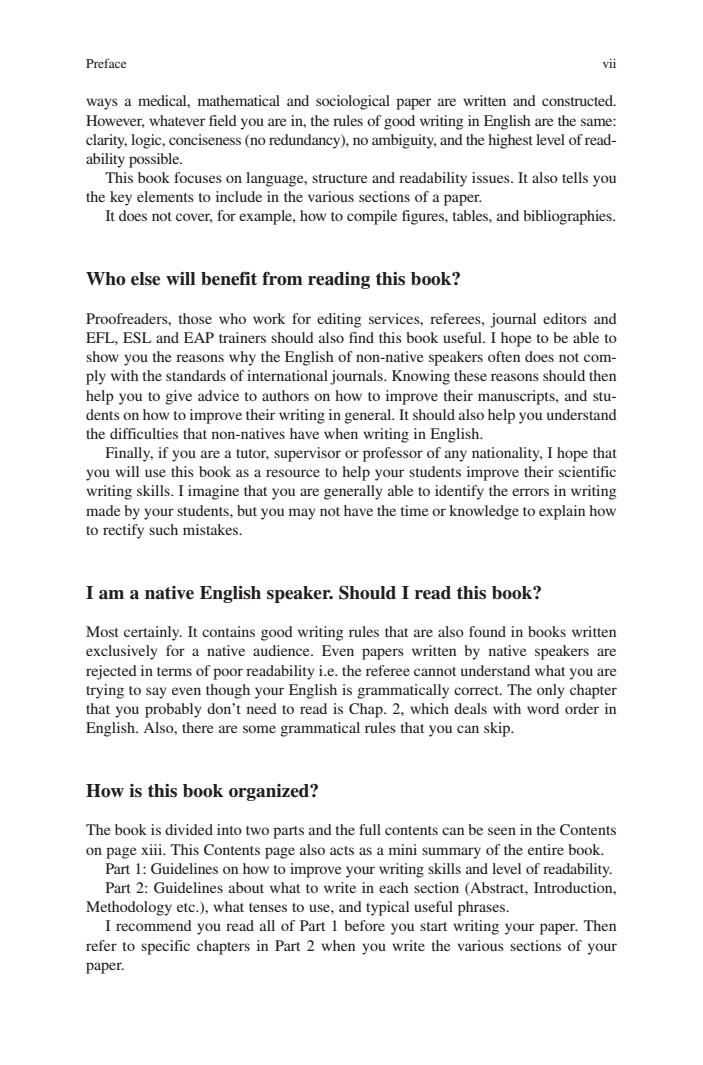正在加载图片...

Preface vii ways a medical,mathematical and sociological paper are written and constructed. However,whatever field you are in,the rules of good writing in English are the same: clarity,logic,conciseness(no redundancy),no ambiguity,and the highest level of read- ability possible. This book focuses on language,structure and readability issues.It also tells you the key elements to include in the various sections of a paper. It does not cover,for example,how to compile figures,tables,and bibliographies. Who else will benefit from reading this book? Proofreaders,those who work for editing services,referees,journal editors and EFL,ESL and EAP trainers should also find this book useful.I hope to be able to show you the reasons why the English of non-native speakers often does not com- ply with the standards of international journals.Knowing these reasons should then help you to give advice to authors on how to improve their manuscripts,and stu- dents on how to improve their writing in general.It should also help you understand the difficulties that non-natives have when writing in English. Finally,if you are a tutor,supervisor or professor of any nationality,I hope that you will use this book as a resource to help your students improve their scientific writing skills.I imagine that you are generally able to identify the errors in writing made by your students,but you may not have the time or knowledge to explain how to rectify such mistakes. I am a native English speaker.Should I read this book? Most certainly.It contains good writing rules that are also found in books written exclusively for a native audience.Even papers written by native speakers are rejected in terms of poor readability i.e.the referee cannot understand what you are trying to say even though your English is grammatically correct.The only chapter that you probably don't need to read is Chap.2,which deals with word order in English.Also,there are some grammatical rules that you can skip. How is this book organized? The book is divided into two parts and the full contents can be seen in the Contents on page xiii.This Contents page also acts as a mini summary of the entire book. Part 1:Guidelines on how to improve your writing skills and level of readability. Part 2:Guidelines about what to write in each section (Abstract,Introduction, Methodology etc.),what tenses to use,and typical useful phrases. I recommend you read all of Part 1 before you start writing your paper.Then refer to specific chapters in Part 2 when you write the various sections of your paper.Preface vii ways a medical, mathematical and sociological paper are written and constructed. However, whatever field you are in, the rules of good writing in English are the same: clarity, logic, conciseness (no redundancy), no ambiguity, and the highest level of readability possible. This book focuses on language, structure and readability issues. It also tells you the key elements to include in the various sections of a paper. It does not cover, for example, how to compile figures, tables, and bibliographies. Who else will benefit from reading this book? Proofreaders, those who work for editing services, referees, journal editors and EFL, ESL and EAP trainers should also find this book useful. I hope to be able to show you the reasons why the English of non-native speakers often does not comply with the standards of international journals. Knowing these reasons should then help you to give advice to authors on how to improve their manuscripts, and students on how to improve their writing in general. It should also help you understand the difficulties that non-natives have when writing in English. Finally, if you are a tutor, supervisor or professor of any nationality, I hope that you will use this book as a resource to help your students improve their scientific writing skills. I imagine that you are generally able to identify the errors in writing made by your students, but you may not have the time or knowledge to explain how to rectify such mistakes. I am a native English speaker. Should I read this book? Most certainly. It contains good writing rules that are also found in books written exclusively for a native audience. Even papers written by native speakers are rejected in terms of poor readability i.e. the referee cannot understand what you are trying to say even though your English is grammatically correct. The only chapter that you probably don’t need to read is Chap. 2, which deals with word order in English. Also, there are some grammatical rules that you can skip. How is this book organized? The book is divided into two parts and the full contents can be seen in the Contents on page xiii. This Contents page also acts as a mini summary of the entire book. Part 1: Guidelines on how to improve your writing skills and level of readability. Part 2: Guidelines about what to write in each section (Abstract, Introduction, Methodology etc.), what tenses to use, and typical useful phrases. I recommend you read all of Part 1 before you start writing your paper. Then refer to specific chapters in Part 2 when you write the various sections of your paper